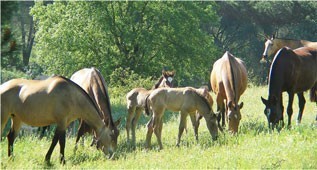
Play Time!
Research published this year suggests that children who play often are likely to grow up more intelligent than those who play less.
Could this also be true for horses?
Have you ever stopped to think about the miracle that every foal undergoes in his journey from being entirely dependent on his mother to an individual that is fully integrated into a herd? So many changes need to happen in the brain and the body of the foal, very quickly and in more or less the right sequence, for the miracle to be realised.
Foals have their first sleep in the first 2 or 3 hours of life, and we know now that this is a precursor to the first stretching behaviours that should occur within four hours. Some say that the stretching is of utmost importance because it suggests that the foal is approaching the final level of physical competence and well-being. In other words, a foal that does not stretch at all has not completed the sequence of early behaviours so critical to future health – and this should give cause for grave concern.
Of course, it makes sense that after an 11 month term in the womb, the muscles and tendons of the foal will be stiff, but he stretches for a more serious reason. The quicker he can get all limbs and other parts of his body functioning perfectly, the sooner he can join the heard and be ready to escape from danger. So the stretching has the function of getting all parts of the foal’s body working efficiently.
To show how important a business this really is, most foals will stretch up to 50 times a day in the first few days of life. In healthy, undisturbed foals, sometimes the stretching can be vigorous but on other occasions, it is relatively motionless and is performed almost casually. With sick foals or those subjected to considerable amounts of stress they may not stretch sufficiently or in certain cases, not at all.
Stretching can occur whether the foal is standing or lying down and there are a huge variety of exercises which the foal puts himself through, very often with his eyes closed. Again, it is most important that humans do not interfere with this process.
Guiding a foal too early into walking around interferes with his natural process of muscle development, of which both sleeping and stretching are a critical part. Not only should the stretching be left uninterrupted, but scientific studies show that the foal should be allowed to perform these activities in a peaceful environment.
The ultimate goal of the foal is to become a fully integrated member of the herd, but in the first few days his entire focus and attention is on his mother. How does he reach the point where at the time of natural weaning, he is part of his own social group and the loss of his mother’s attentions does not cause him undue stress?
In nature the foal’s social transition takes place gradually. And as a result of these slow changes, he experiences ‘emotional toughening’ as well as improved physical development and coordination, as he interacts more with other youngsters.
As early as the first week of life, the foal starts to investigate other foals in the herd. Even at this very early age, he starts to sort out in his mind which of the other foals could be part of his ‘special’ group. So in essence, the foal’s behavioural development is a mixture of spending time with his mother and spending time with other foals. The balance of how this time is spent depends on the age of the foal, but as he matures, he moves to a point where the majority of his time is spent with his peers, rather than his mother.
As the foal grows up, he increases the distance between himself and his mother. Behaviourists have suggested that in the beginning the foal sees his mother as a secure base from which to explore his environment, but as his attention begins to focus more on his peers, the need for the secure base provided by his mother diminishes as he finds increasing, reliable security in being with other youngsters. During this early phase of life, the foal will form a pair-bond, and his association with one individual as well as with the original peer group, endures for life if left undisturbed.
By observing how horses play, which horses they play with and when they play, behaviourists have been able to build up a picture of the likely functions of play.
Play has several important functions for horses:
• In the young horse, it improves blood supply around the body and is, therefore, a crucial part of reaching peak physical performance.
• Play helps herds cohesion and strengthens bonds between individuals
• Play also enables horses to learn to interact appropriately with each other. Without play, social ‘manners’ may never fully develop.
